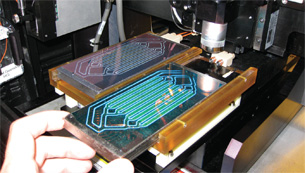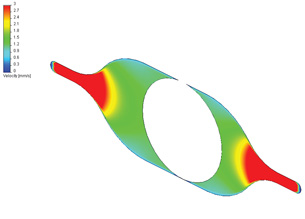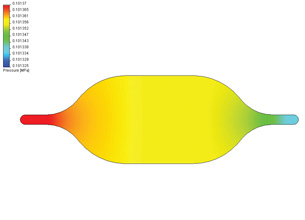Latest News
August 30, 2009
By Christopher Hardee
 Photo of flow cell prototypes being maneuvered under microscope objective for imaging. |
Miniaturization is the holy grail of molecular biology applications such as gene sequencing. One of the reasons is that the reagents—prepared liquid samples used in testing—are extremely costly while the number of genes (bases and proteins) that need identification is extremely large. If you can figure out how to use less reagent while increasing testing speed, then the grail is within grasp. This is where microfluidics comes in.
While the sequencing of the human genome—with its 20,000 to 25,000 genes and one million base pairs—was considered complete in 2003 after a 13-year effort that cost more than $3 billion, the goal now is to develop the capability to map an individual’s genome at a cost the average person can afford. At $1,000, the cost target, each of us could get a copy of our own personal genome—a crystal ball capable of projecting future health or disease. Personalized medicine, as this has been labeled, is a system that all agree would revolutionize medical care and disease prevention. Computational fluid dynamics (CFD) is playing an important role in the race to develop next-generation gene sequencing instruments—with increased throughput, speed, and accuracy—well underway at a number of companies and academic labs.
Designing the Gene Sequencer
“The Polonator is a device we designed to do DNA sequencing,” says Rich Terry, an engineer in Dr. George Church’s genetics lab at Harvard University in Cambridge, MA. The co-developers were Greg Porreca, a researcher in the same lab who invented polymerase colony counting—the genome sequencing method for which the instrument is named—and Kevin McCarthy, chief technology officer at Danaher Motion in Dover, NH, the company that manufactures the instrument. Once the biological methodology had been developed, Terry, who has a degree in aerospace engineering and has worked in high-energy physics, was brought in to design an instrument around the process. “Basically, it’s a next-generation sequencing platform that consists of standard microscope optics with a camera, an illumination setup, a fluidics system, flow cells, and some temperature control.”
 Figure 1: SolidWorks model of final flow cell design with a single inlet and outlet and eight parallel channels. |
While the optics and imaging system are more or less standard, the biggest challenges came from two system designs: the motion control system, which automates camera movement to precise x,y,z coordinates in 90ms increments; and the fluidics system, which controls fluid flow for multiple reagents while ensuring high throughput, uniformity, and accurate critical biochemical reactions. “The design process took about one to one and a half years and CFD was crucial to the process,” Terry says.
Fluidics System Design
Think of the fluidics system like the human circulatory system with a heart that pumps fluid into an artery and in turn is split into a series of small capillaries—the microfluidics. The heart, a reagent block, has wells for as many as 40 reagents. The artery, in this case tubing, feeds each of two flow cells—the capillary-like microfluidic components of the instrument. In each flow cell, the channel splits into eight parallel channels in which the biochemical reactions take place and the results are imaged using the microscope optics and camera.
“There’s one single pump on the system, and the fluids move through the system via vacuum,” says Terry. “It’s really quite simple.” The microfluidics system is further complicated, though, by a number of factors: multiple reagents and washes cycle through the instrument; once the reagents are loaded into the flow cell, they are subject to precisely controlled time and temperature steps so that the biochemical reactions will occur; and most importantly, the reagents must be uniform in concentration and mixing to be accurate.
 Figure 2: Flow cell velocity as calculated using FLUENT CFD analysis, with the inlet represented on the left and the outlet on the right. |
Optimizing Flow Cell Microfluidics
“When I got here,” says Terry, “I started by using CFD to try and improve the flow cell.” At that time, the Church lab team was using a standard microscope flow cell—with a small area and a large volume—that was purchased from a commercial source. “My first pass was to look at things like flow rate and pressure drop…. The CFD analysis showed us the flaws in the current flow cell.”
To model various designs, Terry created 3D models in SolidWorks (see Figure 1). The key variables in the simulation were the channel geometry, especially that of the inlet and the outlet. He then imported the models into CFD software, first using FloWorks (now SolidWorks Flow Simulation) and then FLUENT from ANSYS. Pressure and velocity were analyzed to ensure that reagent concentrations were uniform throughout the cell (see Figures 2 and 3). Terry then ran the simulation on a dual-core PC with run times of about five hours.
The flow cell has an injection-molded polypropylene base 150mm long by 70mm wide with a 100-micron thick acrylic sheet that is used to define the channel height and a 0.15mm thick glass cover slip on top. While the original commercial version had 18 round wells, the CFD analysis indicated uniformity problems, so the current flow cell design takes a different approach with reagents entering the cell in a single inlet that branches into eight parallel channels, each 70mm long and 3.3mm wide. On the downstream side, the eight channels come together into a single exit outlet.
CFD Cuts Volumes and Costs
“Basically the way we bring reagent costs down,” says Terry, “is by decreasing the volume that we need.” To do that, the team decreased the height of the channels, because length and width were fixed. The channel height, which started at 250 microns, was eventually cut to 25 microns without compromising performance. “CFD gave us the ability to look at how gasket height changes flow rates, concentration, and the time it takes to pull fluids through the system,” Terry adds. This tenfold decrease in channel height resulted in a cost reduction for a three-day run from $2,000 to only $200.
 Figure 3: Flow cell pressure as calculated with FLUENT. The inlet (left) shows high pressure and the outlet (right) shows low pressure. |
While Terry describes the CFD problem as average in size, he adds, “CFD gave us the starting point and the ability to tweak designs and look at different concepts before we implemented them and did all the experimental work.” An experimental approach was also used—for prototyping flow cells and setting up robust tests—but CFD was able to condense the design change-prototype-test cycle time. During the design process, Terry went through 10 different flow cell iterations, but noted that the time to get to final design would have doubled or tripled if they had not been using CFD analysis.
CFD and the Biomedical Future
The Polonator gene sequencer is just one example of a microfluidics approach to miniaturization, joining inhalers, catheters, and lab-on-a-chip technology as current examples of this design method.
Some experts say that microfluidics technology is only in its infancy. Terry concurs, adding, “microfluidics has a long way to go and a lot of inroads yet to make in biomedical applications. CFD will play an important role in those developments.”
More Info:
ANSYS
George Church Lab,
Harvard College
Christopher Hardee is a New Hampshire-based freelance writer and marketing consultant who focuses on technical topics and organizations. Send comments about this artricle to [email protected].
Subscribe to our FREE magazine, FREE email newsletters or both!
Latest News
About the Author
DE’s editors contribute news and new product announcements to Digital Engineering.
Press releases may be sent to them via [email protected].






